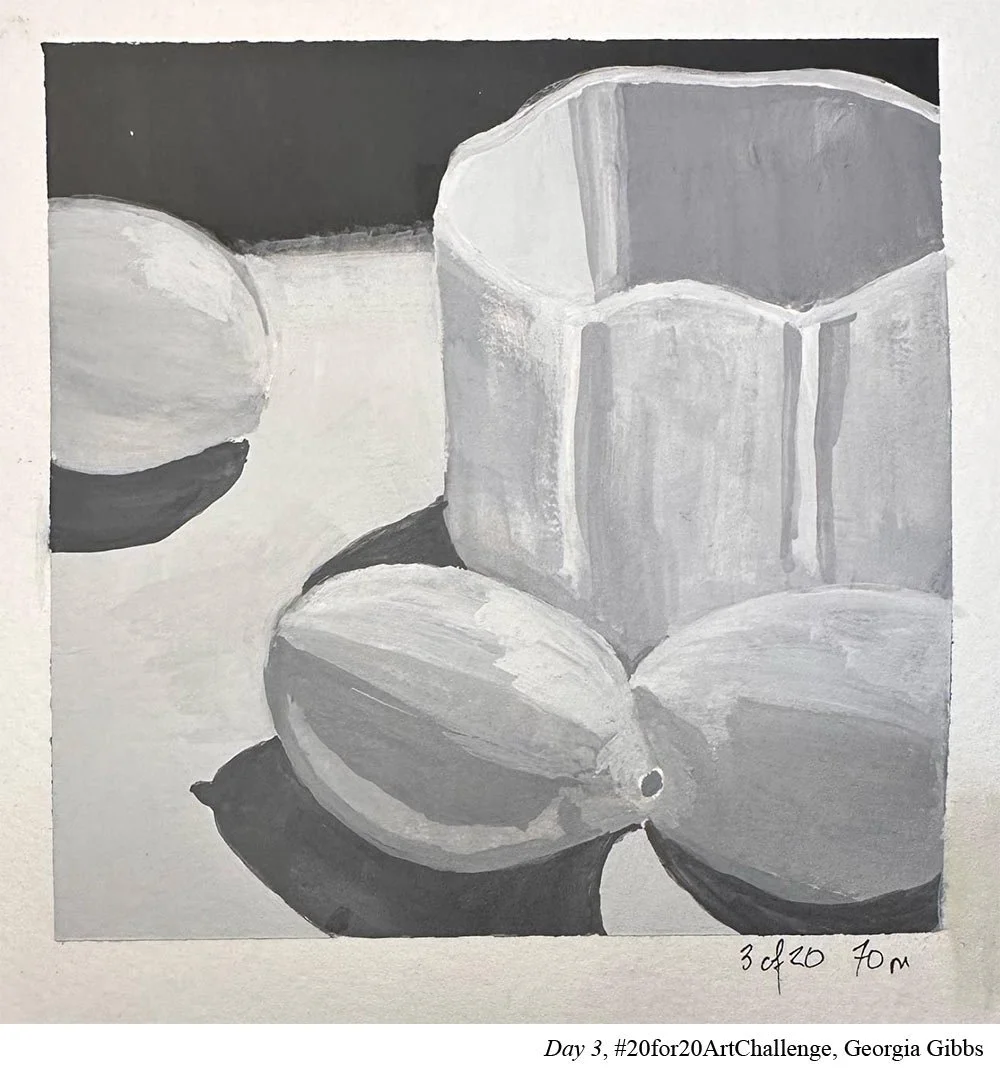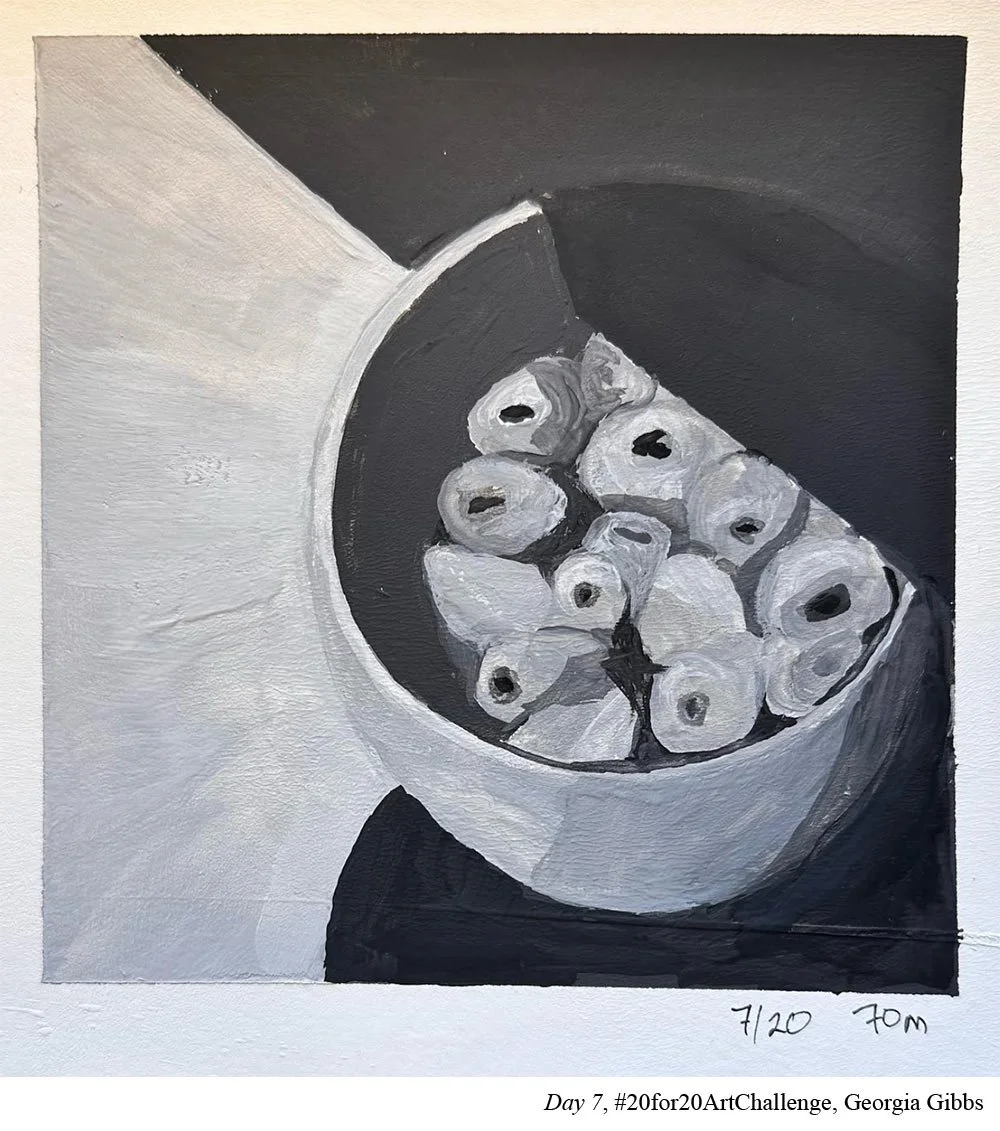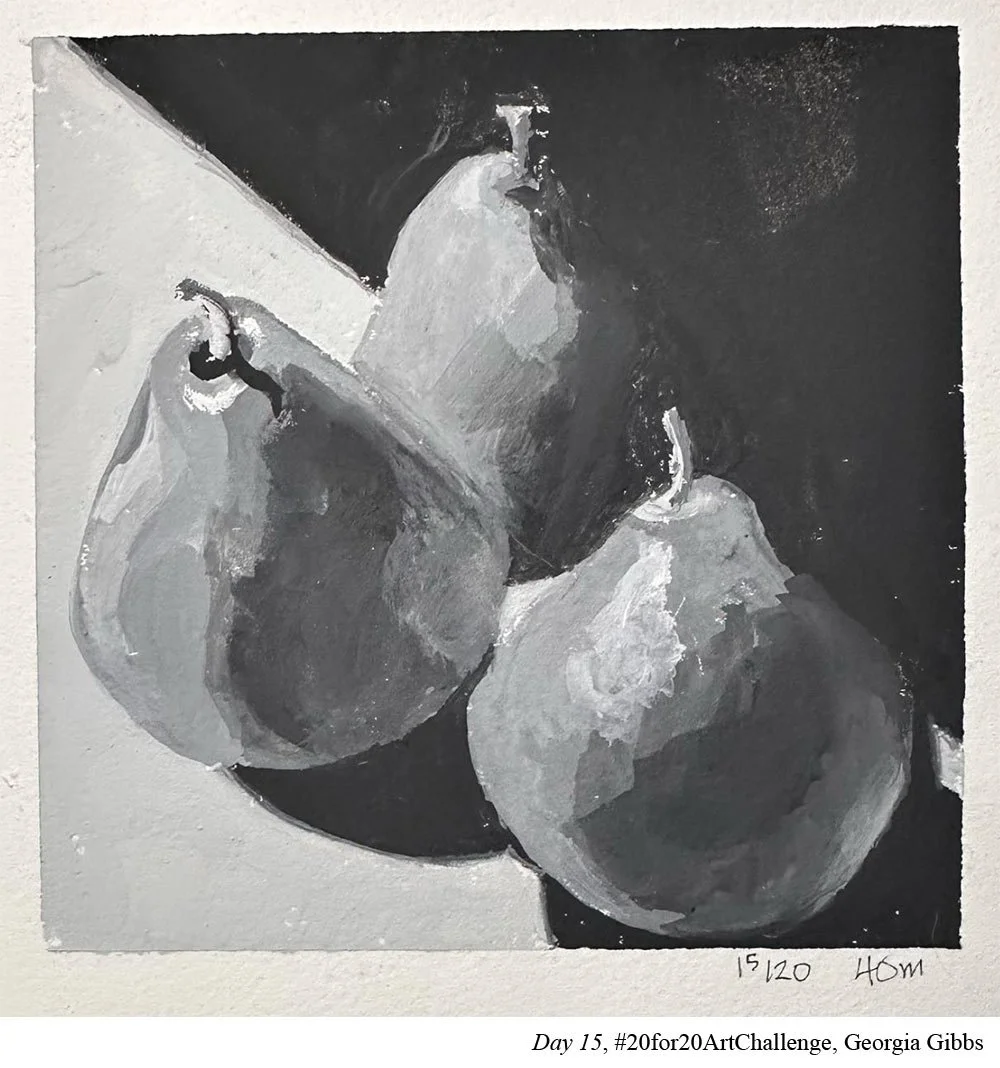Daily Practice - Artist Spotlight - Georgia Gibbs
Artist Georgia Gibbs walked into the #20for20ArtChallenge knowing her focus. She wanted to begin building skills in a new medium. But instead of pulling out a dozen tubes of paint, she pulled out two: white and black. And in doing so, not only did she learn a ton about gouache, but she also had some incredible insights into value.
Learn more about Georgia Gibbs here.
How much did you keep your materials the same for the 20 days?
I decided to work in a uniform size from the start. I like doing a series for the end product. More importantly though it adds to my challenge. I have to account for that dimension and am forced to look at the cropping and take an active role in the design. Even though I used the Reference Starter Pack, I am not just reproducing another person's aesthetic. Instead, I have to think about placement and balance.
For the paint I used Windsor Designer Gouache Ivory Black and Windsor Zinc White. I would like to test out other brands for the white.
I did switch brushes about half way in. I was using a quarter inch and a half inch flat brush with an angled edge - soft synthetics from an inexpensive set. They did not hold a lot of paint and also I could feel myself getting into the weeds with details so half way through I started using a larger round brush, a (12) I believe. It was also inexpensive. I liked that it held a lot of paint and forced me to be less exacting. It was quite liberating giving up that control and I was very happy that I made that change. The work felt more spontaneous and ‘painterly’. It was also supportive of focusing more on shapes–I could not wade into the weeds for the details. I am still not sold on that brush but I will be staying larger going forward. The search is on!
One of your goals was to improve in a new medium. How did working in just black and white help develop your skills in gouache? Do you think you made faster progress in the medium by limiting your colors to just black and white. (Why?)
It was useful working with just gray tones. Part of my challenge was also understanding more fully how values play a role in my work. It felt important to remove the seduction of color.
As to my skills with gouache I am a little on the fence. It helped to maintain the focus on the paint body and characteristics. When I went in and reactivated the layer below it was impossible to hide that: it was obvious so there was no fudging. I had to let it dry and then go back in again to do my adjustments. So it did force one to pay attention and it kept me honest.
How did working on value studies help you get better at simplifying? (Or did it?)
This was one of my happiest discoveries in this process. It was really the combination of the value study and the larger brush. I also had to limit myself to a set number of core values. I found 3 - 4 to be my happy place plus white and black if needed. I would like to simplify even more, especially in doing a study for a larger piece. To be able to convey your intention to the viewer with a minimum of embellishment is a powerful thing.
You can still get a lot of detail with a value study. How did you find you needed to set limits on details or number of values you’re trying to capture?
When I started the challenge I was mixing up a number of values against the gray scale. So each time I was mixing up a pallet of 8 gray tones and painting with a smaller brush. It just felt tight and left little room for exploration or play. So after seeing Sargent’s studies I was inspired to simplify. To try and say more with less.
You mention on Day 4 that things were starting to come together. You mentioned “looking mode” vs “doing mode.” What was the power of adding doing mode to looking mode?
This is also on the heels of Sargent so getting out and seeing art in the real world played a part.
However none of my new insights, blossoming skills, or basic tool knowledge would be available to me had I not been involved in the doing for 20 days.
I started to look at the values, not from the greyscale card at my workstation, but from the reference photo for my painting. I began to let that guide me in establishing the light, medium, and dark values. And I was surprised at how off I had been.
The eye and mind together are so deceitful in a way. They are telling us stories all day long.
I learned to change how I thought and how I worked. At first I would look at something in my reference and say something like, “Oh that is white so I will add a little black to it so it stands up off the page.”
But when instead, I went in and tried to mix for that white and then used the value scale as a tool to confirm my white, I’d find it might not be white at all. It actually might be number 3 or 4 on the scale.
That was kind of a mind blower. And for me, an exciting discovery. A real aha moment.
The looking and the doing really do serve one another.
When you are just looking, it remains an intellectual exercise. It is not until you put your brush to the surface and engage with the other part of your brain that you can really understand what is otherwise just conceptual.
And it’s only through using both together will you have the aha moment and develop your skills.
You decided to use the reference photos from the starter pack? What did having someone else decide the photos and you just followed them give you as an artist?
I was so thankful for those photos. I used them for 2 main reasons: I knew I would overthink it and it would take me hours to pull together 20 images. Because I signed up the day it launched, I did not have that time available. But it was also a piece of control I was hesitant to give up.
I liked that they were, for the most part, nothing that I would ever consider for myself. I don’t paint animals or landscapes. Mostly I work on smaller things that I find or that are in my studio. I knew that using these images would force me out of my comfort zone and really help me grow, which is what the challenge was about for me.
What benefits did you find working daily? How surprised were you by the amount you learned during just 20 days?
I enjoyed working daily more than I can say and learned so much more than I can possibly recount here. Most importantly I learned a lot of practical ways to make daily painting doable for me.
For instance I would find the next day's photo on my iPad the night before after I cleaned up that painting session. And then I would tape off a piece of paper. I was ready to paint as soon as I walked into the studio the next night.
I also learned a lot about values and discovered there is a lot more there to learn. I think for the near term at least, doing a value study will be a part of my process- regardless of the medium- to get ready for a final piece.
By thinking through the values first, I realized how much that helps my discovery process. Both for the process as a whole and from a design standpoint.
It gave me the discipline to show up in the studio daily. This lesson has been invaluable
Sometimes people feel like if they aren’t finishing paintings they aren’t making the most of their studio time. How do you feel committing to 20 days to something that wasn’t officially finished paintings will help you in the long run?
I liked this challenge especially because it was structured but one also had the freedom to set your objective up for the duration. So that is a great combination in my mind.
I really felt that I grew in those 20 days: not just in what I had defined as my objective but in all areas of my work.
Another great aspect was the tremendous community that grew from the process. This was a very positive experience in every regard.
What was the most helpful mindset for you to try and keep during the 20for20? Was there anything that was useful to remind yourself as you showed up each day? What was that and why?
Mostly it was just finishing a goal I had set for myself. There were times I wanted to stop or to skip out or felt like such a loser, but at these times I just reminded myself that my mind was not always my friend and I could tell it to be quiet.
I don’t know anyone who could not grow from this experience. Even just completing it: keeping your word to yourself and meeting your commitment. That is invaluable.
Learn more about Georgia Gibbs here.
Learn more about joining the #20for20 Art Challenge here.










